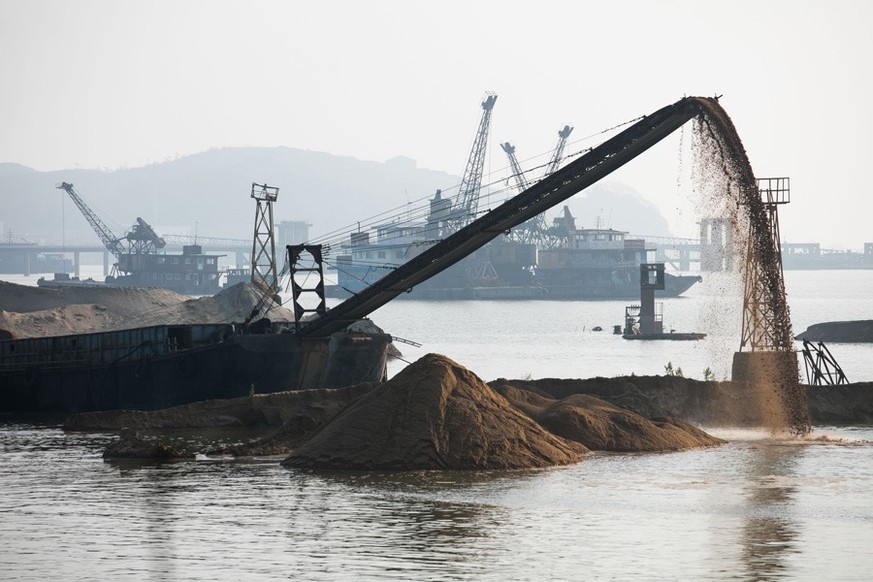When someone mentions the word ‘sand’ the first thing that comes to your mind is most likely a glistening beach in the Bahamas, not the most heavily mined resource in the world. An estimated 40-50 billion tonnes are extracted from the earth each year but like the flip of an hourglass, time may be running out for sand.
From the glass windows in your home to the computer chips inside your laptop, sand is everywhere. The use of sand in construction, mainly when producing asphalt and concrete, is where the major demand comes from, particularly in developing countries such as India, whose sand consumption has tripled since 2000. The United States was among the biggest sand exporters in 2019 and, along with the Netherlands, makeup 41 percent of total exports at a combined value of $686 million. As the world’s largest cement producer, it’s been estimated that China consumed more concrete between 2011 and 2013 than the United States has in the entire 20th century. Such is the demand for sand, we are now seeing smaller countries such as Mozambique joining the market, a country that has increased exports by 292 percent since 2015 (worldstopexports.com). However, in 2019, the United Nations Environment Programme (UNEP) revealed that we are rapidly using up our “sand budget”. For many, the idea of a sand budget may come as a shock. In the era of climate change, we often associate finite resources with fossil fuels, not the humble mineral grains that get stuck between your toes after a walk on the beach. But the concern is justified, and the impacts of intensive mining could be disastrous for the environment and communities around the world.
 Miners of Lagos collecting sand by hand. Source: Sebastian Barros.
Miners of Lagos collecting sand by hand. Source: Sebastian Barros.
One of the leading causes of this rapid depletion has been illegal mining activities. Also known as the “sand mafias”, criminal enterprises have been extracting sand with little regulation. In India, for example, where regulations are managed at a district level, inadequate human resources and financial capacity make it challenging for local authorities to enforce and monitor. Often, those who expose illegal operations are met with aggression. In 2017, The Guardian reported that three men in Jatpura, eastern India, were gunned down when they confronted men mining sand near their village. Because sand extraction is determined by local geography and governance, it’s almost impossible to implement the same set of rules and regulations worldwide.
The price for finding the right grain
Coarse river sand is a prime target for industry: desert sand grains have become too rounded by erosion to bind with concrete, and marine sand contains salt which can corrode metal structures and be expensive to clean. This has put intense pressure on the integrity of our river ecosystems.
In 2018, the World Wildlife Fund (WWF) published a review analyzing existing scientific papers and media articles on sand extraction. WWF’s research highlighted numerous physical impacts attributable to sand mining. Crude methods that involve a conveyor belt delivering buckets to gouge out areas of the riverbed can drastically alter river flow, erode riverbanks, dry up tributaries, lower water tables and trash wetland fisheries. The report also highlighted that changes in water clarity through mining can impact invertebrate communities by affecting drift, the process through which some invertebrates colonize new river sections, escape suboptimal habitats and avoid competition with each other. Aggregate mining can also severely reduce suitable spawning habitats by selectively removing sediments of a specific size. Fish who build hollows for spawning, such as salmon and trout, are only able to do so in sediments with grain sizes smaller than a certain proportion of their body length. Aggregate mining can remove these smaller grains, leaving behind cobbles that are too large for fish to move and, therefore, spawn from.
But the effects are not just environmental, there are also societal and economic impacts. In Morocco, UNEP reports how the “sand mafias” have turned a large beach between Safi and Essouira into a rocky landscape, potentially reducing tourism in the region. In Male, the capital of the Maldives, a review by Kothari and Arnall (2020) published in Geoforum, suggests that the sea defenses are being reinforced using sand dug from offshore islands, thus creating the need for the islands to relocate their populations.
 Intensive dredging along the shores of Poyang Lake in Jiujiang, China. Source: Lu Jian/VCG.
Intensive dredging along the shores of Poyang Lake in Jiujiang, China. Source: Lu Jian/VCG.
Sustainable Solutions for Sand Use
There is hope for the future, with a multitude of different alternatives that can already be explored. In developed countries such as the UK, where new construction often replaces demolished buildings, there is potential to recycle rubble instead of using new concrete. The Shard, a recently built 95-storey skyscraper in London is one example of construction in the UK using recycled aggregate. To help with its green credentials, the Shard was built using 140,000 Lignacite LTD blocks that contain 10 percent recycled sand, 27 percent lightweight recycled aggregate and 15 percent recycled wood. Other substitutes for sand in the production of concrete are also available and are currently being used in Europe, including ash from power station incinerators and dust from stone quarries.
There are also newly emerging companies devoted to green engineering technologies. One such company called ECOncrete® was founded in 2012 by Dr Shimrit Perkol-Finkel and Dr Ido Sella and ‘offers a unique multidisciplinary blend of marine ecologists, biologists, geologists, concrete experts, engineers, designers, working hand in hand to bring concrete to life.’ ECOncrete® set out to offset the damage caused to coastal ecosystems by producing concrete structures that contain bioactive ingredients which encourage the growth of marine life.
The 2019 UNEP report on sand sustainability championed the use of recycled aggregates as a way forward in reducing the amount of sand being used in construction. The report also suggested that improving building design would increase efficiency and help reduce the amount of sand being used per project. However, the authors indicate that for these solutions to be implemented successfully, there needs to be clear communication between international organizations, private sector companies, national governments and local communities. Without this established communication, there will continue to be no accountability and transparency within the sand mining industry.
Europe has shown that developed economies can continue to prosper without mining valuable river ecosystems for sand. The question now is what can be done to reduce the demand for sand in rapidly developing countries in Asia and Africa. The United Nations Environment Programme, when commenting on the effort needed to address our sand crisis, has said that ‘the type of societal shift needed is like that required to address climate change’. But because sand is so cheap, at less than $10 a ton, it may be unrealistic to think we can make a sudden switch away from this natural resource. And so, companies that focus on making sand-based products more sustainable and eco-friendlier is certainly a step in the right direction.
By Ellis Moloney, ECO Contributor
Further Reading:
Kothari, U. and Arnall, A., 2020. Shifting sands: The rhythms and temporalities of island sandscapes. Geoforum, 108, pp.305-314.
UN Environment 2019 Report: Sand and Sustainability: Finding new solutions for environmental governance of global sand resources
WWF 2018 Review: Impacts of Sand Mining on ecosystem Structure, Process and Biodiversity in Rivers by Lois Koehken





